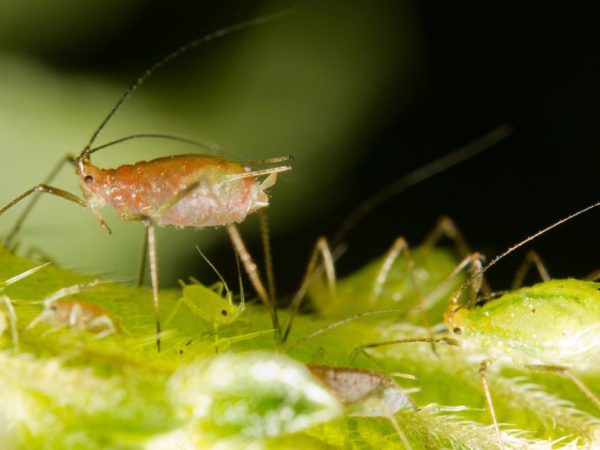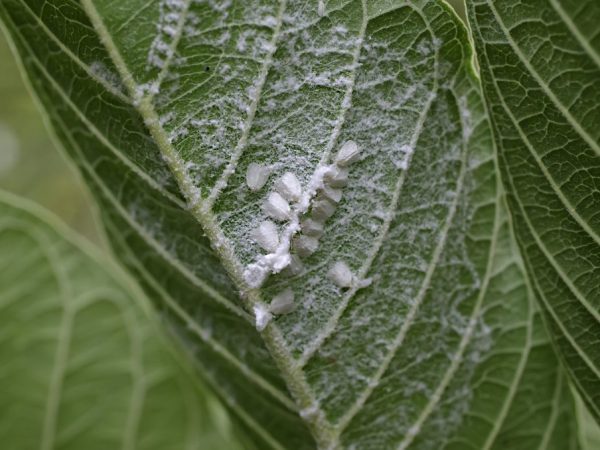Pests of pepper seedlings and methods of dealing with them
The most common cause of death of young plants is harmful insects that carry diseases. Pests of pepper seedlings destroy plantings very quickly, so you need to fight them in a timely manner.

Pests of pepper seedlings and methods of dealing with them
Where do pests come from?
Most often, pests and diseases are introduced through poor-quality soil and seed that has not been processed.
Types of pests and methods of dealing with them
There are a huge number of insects that feed on juices, rhizome and ovary of peppers. Consider the most common pests of pepper seedlings.
Aphid
Aphids are an insect that, gathering in a colony, settles on almost all indoor, garden plants and seedlings. It is small in size, green or dark gray. Her body is protected by a chitinous shell.
The insect's mouth apparatus is designed to pierce delicate young leaves, but the coarse shell is too tough for it, so the colonies prefer to settle on the tops of the pepper.
Aphids suck the juices from the plant, and it withers, sheds leaves, stops growing.
At the first signs of the appearance of a sticky layer on the underside of the leaves, urgent measures should be taken to combat pests of pepper seedlings. Curling of the upper leaves is also a sign of the presence of insects.
In the fight against aphids, plants are sprayed with infusion of wormwood, onion and garlic husks. These odorous solutions keep pests away for a long time. You can also wash off insects with a regular jet of water, but this method is more suitable for grown seedlings.
Wireworm
Another pest of pepper seedlings is wireworm. It does the same harm to plantings. The insect infects the root of the plant itself and the underground part of the stem. This kills the seedling slowly. He is very stunted or may die altogether.
Beetle larvae are dangerous. They are small in size, with a tough body. These creatures live at a depth of 10-15 cm underground and are brought into the seedling box only with the substrate. To prevent the appearance of the pest, the soil is calcined before planting.
The soil is watered with a strong solution of potassium permanganate, but it is best to purchase a substrate for growing pepper seedlings. There are no pests in such soil, its composition is completely balanced.
Spider mite
The defeat of seedlings with a spider mite is noticeable immediately. Whitish or almost transparent cobwebs appear on the plant. They wrap the ground in a seedling box, eventually spreading to the entire plant.
Spider mites are carriers of many diseases. They feed on the sap of the plant and thereby weaken it, and also infect the pepper with viral diseases.
Removing the cobweb manually is not enough; you need to deal with the cause of its appearance. The infusion copes well with this, for the manufacture of which you will need:
- tobacco (you can use the one found in cigarettes);
- milk serum;
- wood ash.
All ingredients are mixed and infused for several days in a cool place, occasionally shaking the container. After that, the liquid is sprayed on the plants and the ground around them. If the seedlings are grown in an apartment, it is worth treating the pots with indoor plants.
Whitefly

Get rid of insects as soon as possible
This small winged insect causes significant damage to plants growing in greenhouses. It is difficult to see them with the naked eye. To check, the seedling must be shaken slightly, then they will become noticeable.
You can detect the presence of a whitefly in a greenhouse by the presence of yellow spots on the surface of the leaves. They look a bit like sunburns, but even after shading, they continue to grow in size. There is also a whitish coating on the underside of the plate.
This pest of sweet pepper is afraid of the infusion of wormwood, garlic and yarrow. Also, the front sight reacts strongly to a sharp change in temperature. On a hot day, it is recommended to water the sweet pepper seedlings with cold water: pests are most often disoriented and fall to the ground. At this stage, the flies are sprinkled with a layer of soil.
If there are too many whiteflies in the greenhouse, fighting them with folk remedies is useless. It is necessary to use pesticides: Fitoverma, Vertimeka, Pegasus, Talstar, Aktara, Intavira.
Thrips
If silver spots appear on sweet pepper seedlings, which constantly increase in size, the reason for this is a small butterfly. This insect has an unusual name - thrips.
They fall into the soil when fertilized with organic waste, as well as fresh mullein. Insects multiply rapidly and the entire colony feeds on pepper juices. This depletes the plants, leads them to stunted growth and death.
Since butterflies cannot pierce the surface of adult leaves, they feed on the apical bud and young leaves.
It is recommended to fight thrips by spraying the plantings with a solution of whey and garlic. Dusting with wood ash is also used.
Medvedka
This underground pest damages the roots of the pepper and leads to its death. Medvedka gets into the soil from manure, which fertilizes the beds. She also loves compost heaps where she lays eggs. The pest can come from another site.
It is easy to detect the pest by walking in the soil. It is useless to try to catch a bear, since the period of its activity is at night.
To combat it, odorous baits with poison are made. To do this, the yolk of a hard-boiled chicken egg is mixed with onions fried in vegetable oil. Poison is also added there (any drug from the Colorado potato beetle, but in a strong concentration)
Small balls are formed from the mixture and laid out around the perimeter of the site, as well as near the passages. Do not be afraid that the bait will be eaten by animals, since the poison is not dangerous for mammals.
Prophylaxis
Many pests not only damage the shell of the pepper itself and feed on its juices, but also infect it with various diseases. This speeds up the death of the landings.
It is easier to prevent infestation by pests than to deal with them later. There are several principles to follow:
- Ignite the soil before placing it in the seedling box. This is done in an iron container with a wide bottom. Do not heat it for too long, as heat treatment significantly reduces the content of minerals in the soil. You can also just pour boiling water over the ground.
- Treat the soil with a manganese solution or phytosporin. Both of these methods are equally effective. Most pest larvae do not tolerate their exposure.
- Refrain from fertilizing greenhouse beds with fresh cow and horse manure, as well as chicken droppings. Many insects reproduce under these conditions. It is better to apply rotted fertilizer.
- Plant pungent-smelling plants in the greenhouse. They repel aphids, thrips and whiteflies.For these purposes, it is recommended to plant black shaves, majors, onions, garlic and basil.
Conclusion
If you do not take preventive measures and do not take action to control insects, you can lose plantings.
It is much more difficult to protect seedlings in a greenhouse than in open ground, therefore, they often resort to spraying with pesticides.


